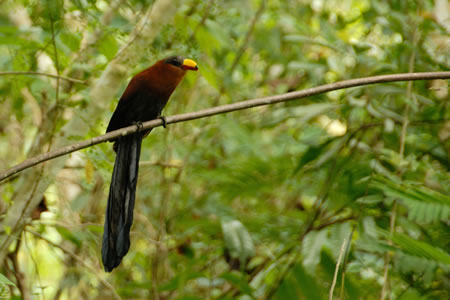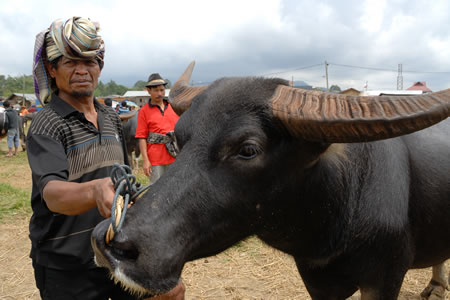English | Dutch |
|
| Crosswise through Sulawesi | |
Batuputih (Indonesia) to Rantepao (Indonesia), Sep-06-08 / Sep-27-08 |
|
After our visit to the Tangkoko Nature Reserve, we travelled back to the city of Manado. Ivonne still has an inflammation of the ear, which makes it not wise to do more dives. We still have the plan to return to Bunaken Island somewhere in the coming week, to do some more diving, just to get some extra experience. However, as long as the ear of Ivonne is not recovered, we have to postpone that idea. For that reason, we decide to visit the Banani Nani National park first, six hours westerly from Manado by bus by bus. We find a place to stay at the home stay of Aunt Mien in the village of Dolodou, close to the entrance of the Banani Nani National Park. A home stay is a place where you stay with a local family. You will find them often in the places that are too small for a hotel or guesthouse. Most home stays offer and all-inclusive package. That means that you pay one price for the room, including three meals per day. Aunt Mien is mercantile. She asks 150,000 Rupiahs per person per night (€ 11.-), and that is a huge amount for Indonesian standards. We do not have a good situation to negotiate, because she has the only home stay of the village. So at the end we pay the demanded price. |
|
 |
|
AYellow-Billed Malkoha in Banani Nani Wartabone National Park |
|
| We stay with Aunt Mien for a couple of days to visit the national park. And as often with Indonesian Nature Reserves, also this reserve is the victim of the ongoing clearance of the forests. There are a lot of agricultural activities going on in the park, and in the far distance you can hear the chain saws making the situation worse and worse. We decided to do only day walks, which mean that we can only visit the border area of the national park. It is still a nice park, but don’t expect untouched jungle. We use the evening hours to discuss how we want to spend our remaining time in Sulawesi. We really do not look forward travelling over land all the way to south Sulawesi. We have to be in Makassar (South Sulawesi) at the beginning of October for our flight to Kuala Lumpur in Malaysia. The bus journeys in Sulawesi are long, tiring and uncomfortable. And that’s something that we do not look forward too. Besides that, we still want to do some more dives. Bunaken is the best place for us as non experienced divers, because we know the people over there. And if we decide to go back to Bunaken for a week or so, we can decide to fly from Manado to Makassar, which means that we cut out the bus rides. However, as long as Ivonne’s ears are not healed, diving is no option. Eventually, we decide to travel further west, to the city of Gorontalo. It takes us a full day to get day and another day to see the city. If Ivonne’s ear is healed by that time, we can decide to go to the Togean Islands to do some diving, and otherwise we are ‘condemned’ to take the bus south. We spend an extra day in Gorontalo to see the city. As expected, Gorontalo is not an interesting city. It is like most other Indonesian cities: hectic, hot, and not much to see. After the two days, the ears of Ivonne are not fully recovered yet. It is going much better, but not good enough to jump into the water again. For that reason we decide to postpone our diving plans for after Sulawesi. It also means that the bus is the only reasonable option to travel further south, because the flights from Gorontalo are too expensive. So eventually we end up at the Damri bus office for two tickets from Gorontalo to Palu. The price per ticket is 120,000 Rp per person (€ 9.-) and the planned length of the journey is 18 hours (departure at 10.00 am and estimated arrival at 04.00 am). | |
 |
|
A proud owner and his water buffalo on the market of Bolu |
|
The journey goes by as expected. It was a long and uncomfortable ride, but at the end we are happy that we did it (see also the article: Caught by the Paparazzi in Sulawesi). We took a rest day in Palu to see the city and to recover from the bus journey. Also Palu is not an interesting city to visit, so we mainly used it as our stepping stone to Lore Lindu national Park. The park is rarely visited by travellers because it has a lack of facilities, is difficult to reach and is located in an area that was plagued by religious conflicts not so many years ago. At the beginning of this century, central Sulawesi (areas around Palu, Poso and Tentena) was the scene where Christian and Muslim militias where responsible for death and destruction. The unrest stopped in 2005 (last bombing), and since than it is calm again. However, many western government still advice not to travel to these areas, or to take precautious measures when you really have to go there. But because the conflict was never directed towards travellers, we decided to travel through this area. Our planned visit to Lore Lindu National Park was not really a success (see also the article: I prefer Nasi Goreng). After Palu we travelled via Poso, where we stayed one night, to the village of Tentena, located on the shore of the Poso Lake. Both cities have no particulars sights that are interesting, so after a couple of days we travelled south to the city of Palopo in South Sulawesi. We hoped to travel in one day from Tentena all the way to Rantepao (in the Tana Toraja district), but because the bus was delayed, we had to spend one night in Palopo. Tana Toraja was our next interesting travel destination. It is a beautiful area in Southern Sulawesi, surrounded by mountains where the traditional cultures somehow managed to survive over the centuries. Especially the traditions around death are interesting and macabre. Funerals go hand in hand with often large-scale sacrifices of especially water buffalos and graves are guarded by effigies of the deceased. So, it’s an interesting place to spend so time. We stayed in Tana Toraja for a week and we are now preparing ourselves for the last journey in Sulawesi, the bus ride from Rantepao to Makassar.
|
|
| <Previous weblog> | |